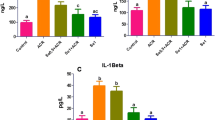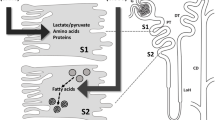Abstract
Glutamine transaminase K(GTK) excretion assessed in urine and by kidney histology was evaluated in rats after single treatment with 1.0 mg/kg i.p. of mercuric chloride, 100 mg/kg i.p. of hexachloro-1:3-butadiene (both S3, pars recta, segment-specific nephrotoxicants) and 25 mg/kg s.c. of potassium dichromate (S1–S2, pars convoluta, segment-specific nephrotoxicant). The aim was to correlate segment-specific injury and enzyme excretion in order to assess, using non-vasive methods, localization of GTK along the proximal tubule. Mercuric chloride and hexachloro-1:3-butadiene produced early focal damage in the pars recta (focal necrosis was shown 10 h after treatment, and diffuse necrosis appeared later at 34 and 24 h after treatment). Changes of the pars convoluta were occasional and delayed (72 h after treatment for both substances). On the contrary, potassium dichromate induced damage of the pars convoluta (vacuolar degeneration and focal necrosis were evident 24 h and 48 h after treatment, respectively), whereas the pars recta was affected later (focal vacuolar degeneration was observed 72 h after treatment). Increase urinary GTK excretion was early after treatment with mercuric chloride and hexachloro-1:3-butadiene (significant increase was observed within 10 h), with a peak for both substances 24␣h after treatment, in agreement with the necrosis of the pars recta. Potassium dichromate induced a significant increase of enzyme excretion in urine also 24 h after injection, according to histological features showing vacuolar degeneration of the pars convoluta; the peak of excretion was reached 48 h after treatment (delay was due, probably, to s.c. administration). The results show that GTK increased in urine after treatment with S3 and S1–S2 specific nephrotoxicants; the combination of histological examination and urinary enzyme supports the evidence that the enzyme is distributed along the whole of the proximal tubule.
Similar content being viewed by others
Author information
Authors and Affiliations
Additional information
Received: 16 February 1998 / Accepted: 30 March 1998
Rights and permissions
About this article
Cite this article
Trevisan, A., Cristofori, P., Fanelli, G. et al. Glutamine transaminase K intranephron localization in rats determined by urinary excretion after treatment with segment-specific nephrotoxicants. Arch Toxicol 72, 531–535 (1998). https://doi.org/10.1007/s002040050538
Issue Date:
DOI: https://doi.org/10.1007/s002040050538




